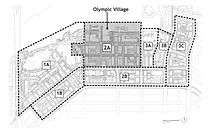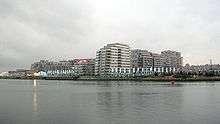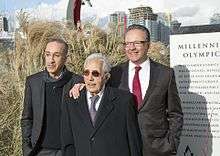2010 Olympic Village
For the location of the Olympic Village in Singapore, see Nanyang Technological University or 2010 Summer Youth Olympics#Youth Olympic Village

The Vancouver Olympic Village (VVL), is an Olympic Village built by Millennium Development Group for the 2010 Winter Olympics and 2010 Winter Paralympics hosted in Vancouver, British Columbia, Canada.[1] There are over a thousand units, ranging over a million square feet, that was able to accommodate over 2,800 athletes, coaches, and officials for the 2010 Winter Olympics.[1][2]
The site, a former industrial area which mostly consisted of parking lots, is located on the shoreline at the southeast corner of False Creek, north of Second Avenue between Quebec and Manitoba Streets. Just south of Science World, its waterfront is part of the False Creek Seawall promenade and bike route, and is adjacent to the stations of the Granville Island Heritage Railway, the Spyglass Place pedestrian ferry wharf (served by Aquabus and False Creek Ferries), the Science World pedestrian ferry wharf (normally served by Aquabus and False Creek Ferries but closed temporarily from 25 January 2010 to 24 March 2010[3]) and the Main Street and Olympic Village SkyTrain stations.
Whistler Olympic and Paralympic Village
The Whistler Olympic and Paralympic Village (WVL) is located in Whistler, British Columbia, it served the 2010 Winter Olympics and the 2010 Winter Paralympics. Smaller than the VVL, it accommodated 2,400 athletes, coaches, and officials with 450 beds made especially with wheelchair access. Site preparation began in 2006 with construction starting in March 2007 and it was completed in Summer 2009.[4]
About
The site has 252 affordable housing units and another 100 units are for "modest market housing". Southeast False Creek is the designation given to the neighbourhood the Olympic Village resides in, bordered by Cambie, Main, West 2nd Avenue, and False Creek.[5] The City of Vancouver projects that Southeast False Creek will eventually become home to up to 16,000 people by 2020.[6]
The site currently boasts a 45,000 square foot community centre, named the Creekside Community Recreation Centre.[7]
Construction


Preparation and construction of the site Vancouver began in February 2006. Construction was completed on 1 November 2009 by the Millennium Development Group, and turned over to the Vancouver Organizing Committee for the 2010 Olympic and Paralympic Winter Games (VANOC) for use during the Winter Games. On 7 April 2010 it was returned to the City of Vancouver. The village was converted into residential housing, a community centre, daycare, retail, and service spaces.[2][8]
Residents released video documenting major problems with their units, including water pouring out of light fixtures, heat not working, cracks in ceilings, hardwood floors bubbling from moisture and bedrooms too small to fit a bed. More than 60 condo owners at the Village filed a class-action lawsuit against the builder.[9] The lawsuits were subsequently dropped.
On December 12, 2014, the City of Vancouver unveiled a plaque honouring Millennium Development Group's role in designing, developing and constructing the Olympic Village, named "Millenium Water Olympic Village". The wording on the plaque states:
"North America's first leed platinum community was designed, developed and constructed by Peter and Shahram Malek's millenium development group in time to open as the athletes' village for the successful Vancouver 2010 Olympic and Paralympic Winter Games.
Formerly an industrial site, millenium water Olympic Village was the catalyst for the revitalization of the surrounding false creek neighbourhood and is a testament to the innovation, hard work and community spirit of the Malekyazdi family and hundreds of men and women who helped make this vision a reality."
Funding crisis
On January 15, 2009, Jody Andrews, the deputy city manager overseeing construction of the Olympic Village, resigned.[10] Vancouver city manager, Penny Ballem, said "There was no reason for the public to lose confidence in City Hall over the resignation".[10]
Vancouver Mayor, Gregor Robertson, made a request to the British Columbia provincial government to allow the City of Vancouver to borrow additional funds to complete the project.[10] On January 18, 2009, an emergency meeting convened by the BC Legislature approved Bill 47, allowing the City of Vancouver unlimited access to additional funds for the development of the Olympic Village.[11] The estimated new total cost is CAN$1 billion to build VVL, approximately CAN$ 467 million dollars were required by the City of Vancouver to complete the project. The project ran into financial woes late last year as well as the lender, Fortress Investment Group, a New York hedge fund, stopped payments to the village's holding company, SEFC Properties Ltd. Bill 47 is an unusual amendment to the charter for the Olympics in that it changes the original requirement that all additional borrowing is prohibited without a public referendum,[11] and also that it was until this legislation was passed that it was illegal for the City of Vancouver to pursue such financial dealings. The city, in order to meet its Olympics commitments, required extraordinary legislative proceedings to amend the city's charter to allow it to borrow to buy out the loan from Fortress.[12][13]
In November 2010, seven months after the successful completion of the 2010 Olympic Winter Games, the village's holding company and the City of Vancouver agreed to place the property into voluntary receivership.[14]
A review by Rob MacDonald, a noted Vancouver developer, for the Vancouver Sun, and subsequently by others, praised the developer, Millennium Development Group, for their accomplishment in creating the Vancouver Olympic Village under trying circumstances.[15][16]
Australia banner controversy
A giant banner hung from the Village by members of the Australian team attracted controversy in early February 2010 when a member of the International Olympic Committee toured the site and expressed concern that it might contravene policy, as the banner is not the flag of Australia but rather depicts a kangaroo wearing boxing gloves.[17] The Australian deputy prime minister at the time Julia Gillard called the request for the banner's removal a disgrace.[18] According to a representative of the Australian team, the flag has been at every Olympic Village since the 2000 Games in Sydney.[17] The image had flown from the victorious Australian yacht in the 1983 America's Cup and is now a mascot of Australia's Olympic teams; the Australian Olympic Committee owns the image's trademark.[19] After IOC president Jacques Rogge discussed the issue with John Coates, chief of the AOC, it was confirmed that the flag could remain at the Olympic Village. "While the IOC is of the view that the display of the boxing kangaroo at the Olympic village is a breach of the IOC rules relating to clean venues, the IOC is not going to request us to take down the boxing kangaroo flag on this occasion," Coates said.[20] The AOC was required to register the image with the IOC.[21] The controversy sparked a demand for a version of the boxing-kangaroo flag at a Vancouver flag shop.[21]
References
- 1 2 "Southeast False Creek and Olympic Village". City of Vancouver. 26 February 2007. Retrieved 7 March 2007.
- 1 2 "About the Olympic Village". 12 January 2007. Archived from the original on 4 May 2006. Retrieved 7 March 2007.
- ↑ "Olympics to close three waterways to boat traffic", Vancouver Sun, 30 April 2009
- ↑ Langworth, Edda. "Durfeld Constructors - Whister BC - Whistler Olympic Athletes Village". www.durfeldlogconstruction.com. Retrieved 2016-08-10.
- ↑ "Southeast False Creek Planning". City of Vancouver. Retrieved 7 February 2012.
- ↑ City of Vancouver (12 July 2010). "About SEFC & Olympic Village". Vancouver.ca. Retrieved 28 January 2012.
- ↑ City of Vancouver (11 August 2011). "Southeast False Creek & Olympic Village". Vancouver.ca. Retrieved 28 January 2012.
- ↑ "2010 Villages". Vancouver Organizing Committee. Archived from the original on 30 December 2006. Retrieved 7 March 2007.
- ↑ Gary Mason (12 April 2011). "A $1.8-million Olympic Village dream turns sour". The Globe and Mail. Canada. Retrieved 28 January 2012.
- 1 2 3 "Deputy Vancouver manager in charge of Olympic Village resigns", CBC, 18 January 2009
- 1 2 "Vancouver gets OK to borrow for $1B Olympic Athletes' Village". CBC News. 18 January 2009. Retrieved 18 January 2009.
- ↑ "Vancouver assumes financial control of Olympic village". Associated Press. 18 February 2009. Retrieved 18 February 2009.
- ↑ Speech by Corky Evans in the BC Legislature, Thursday, 29 January 2009, from BC Hansard, Legislature Raids/Basi-Virk Trial webpage]
- ↑ The Economist, "Up False Creek: The cost of a property deal gone sour", 15 January 2011, p. 40.
- ↑ "This development has turned out exactly as we envisioned it. People like living here", Vancouver Sun, 30 April 2014
- ↑ "How city hall messed up Millennium Water", Vancouver Sun, 16 October 2010
- 1 2 Wintonyk, Darcy (5 February 2010). "Kangaroo flag at athletes village causes IOC flap". ctvbc.ca. Archived from the original on 8 February 2010. Retrieved 11 February 2010.
- ↑ Silkstone, Dan (10 February 2010). "They shoot kangaroos don't they?". The Sydney Morning Herald. Archived from the original on 13 February 2010. Retrieved 11 February 2010.
- ↑ "Boxing kangaroo banner still hanging". CBC News. 5 February 2010. Archived from the original on 9 February 2010. Retrieved 11 February 2010.
- ↑ Wilson, Stephen (7 February 2010). "IOC allows Australia to keep boxing kangaroo flag in Olympic village". Winnipeg Free Press. Associated Press. Archived from the original on 12 February 2010. Retrieved 11 February 2010.
- 1 2 "Boxing 'roo wins fight at Athletes' Village". CBC News. 8 February 2010. Archived from the original on 11 February 2010. Retrieved 11 February 2010.
External links
| Wikimedia Commons has media related to Olympic Village, Vancouver. |
- Vancouver2010.com profile
- Government of British Columbia
- City of Vancouver
- News and photographs of the completed Vancouver Olympic Village
- Photograph of the construction of the Olympic Village in False Creek
- Photograph of Olympic Village footbridge installation Dec 2007
- Vancouver releases secret Olympic Village documents, Bob Mackin, The Tyee, 19 June 2009
- The Growing Pains of Vancouver - Internet radio documentary discussing the Olympic Village from 45'21" till 64'24".
Coordinates: 49°16′15″N 123°6′24″W / 49.27083°N 123.10667°W

